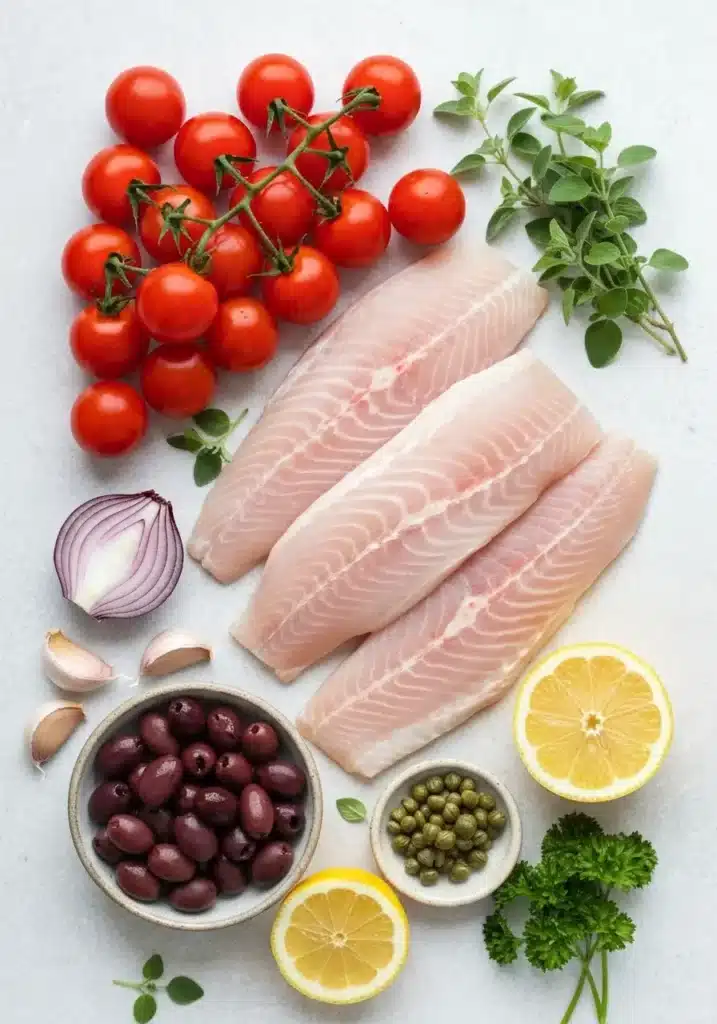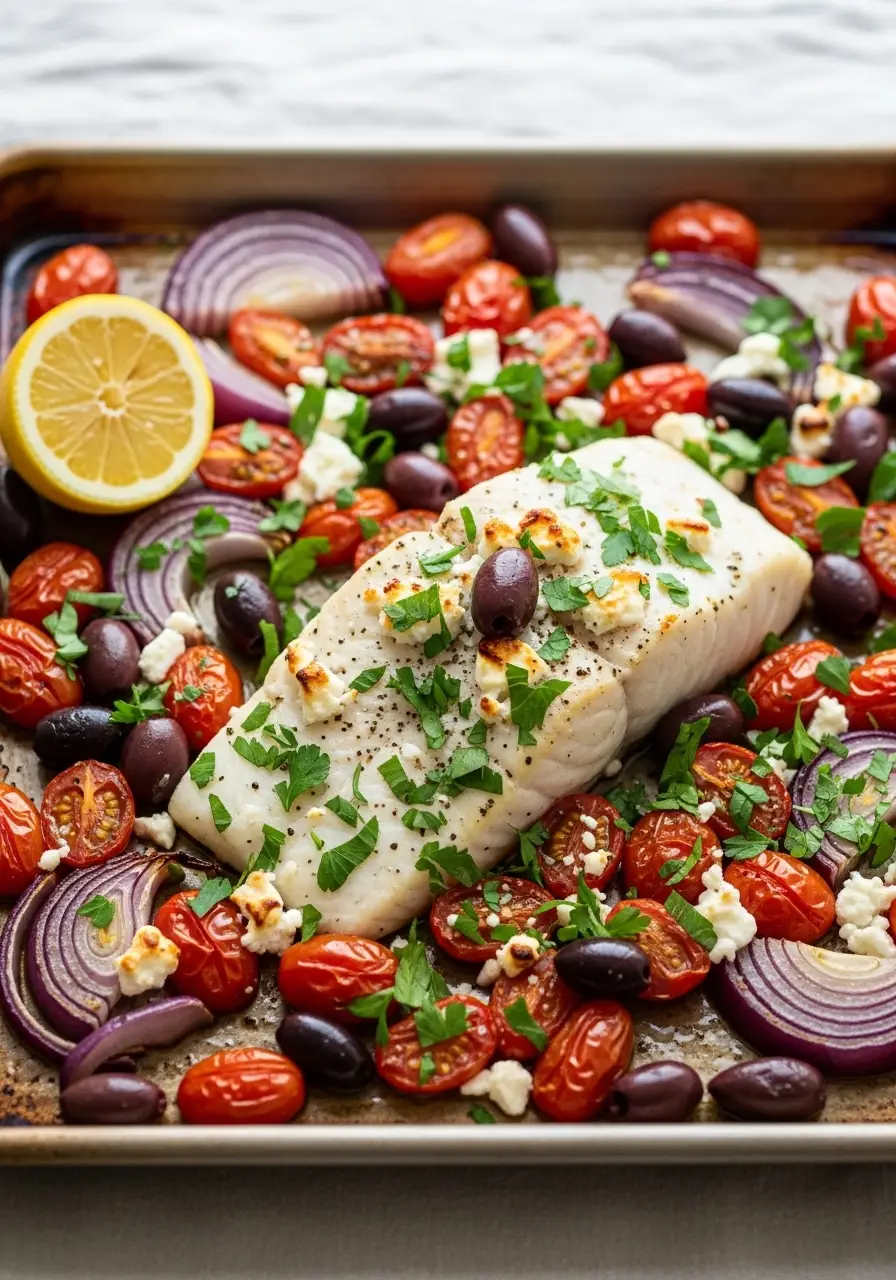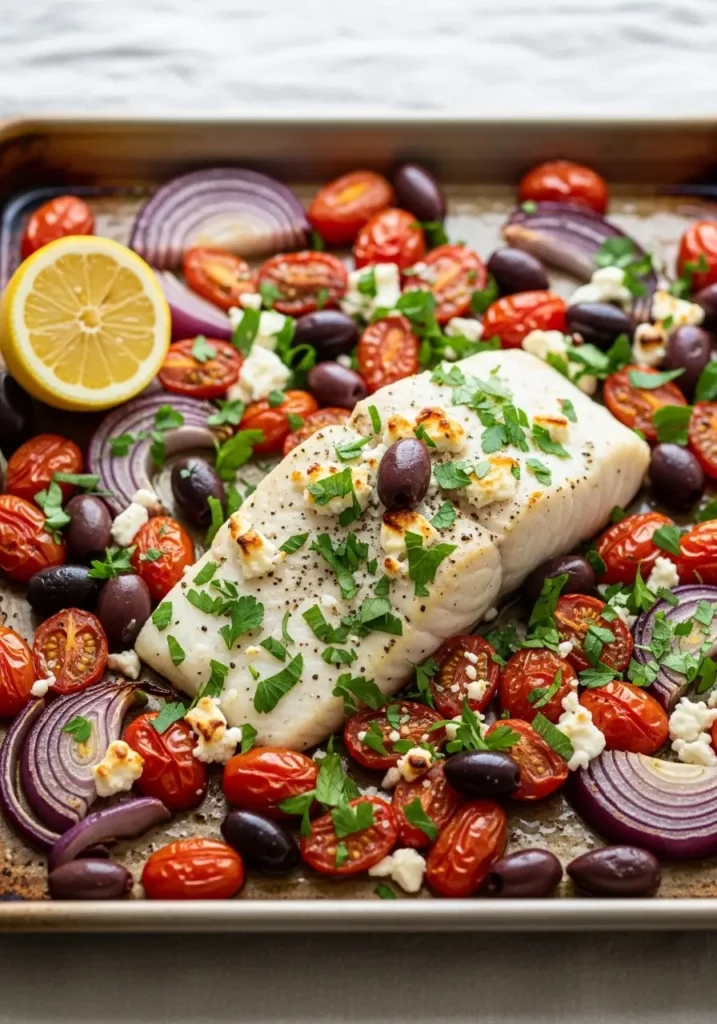Transport your kitchen to the sunny shores of the Mediterranean with this incredibly simple and deeply flavorful Mediterranean Halibut Recipe. This isn’t just another fish dinner; it’s a vibrant, healthy, one-pan meal that comes together in under 30 minutes. Imagine flaky, tender halibut baked to perfection alongside sweet burst cherry tomatoes, briny Kalamata olives, zesty lemon, and fragrant herbs. It’s a restaurant-quality dish that’s surprisingly easy to make on a busy weeknight.
We’re combining the best of coastal cuisine in a single sheet pan, which means maximum flavor with minimal cleanup. If you’re looking for a healthy, gluten-free, and low-carb meal that doesn’t compromise on taste, you’ve found your new favorite.
Why You’ll Love This Mediterranean Halibut Recipe
- Quick & Easy: With just 10 minutes of prep and about 15 minutes of bake time, this is the perfect weeknight wonder.
- One-Pan Meal: Everything cooks together on a single sheet pan, making cleanup an absolute breeze.
- Healthy & Nutritious: Packed with lean protein, healthy fats from olive oil, and vitamin-rich vegetables, it’s a meal you can feel great about.
- Incredibly Flavorful: The combination of sweet tomatoes, salty olives, tangy capers, and fresh herbs creates a symphony of classic Mediterranean flavors.
The Key to Mediterranean Flavor
What truly defines a Mediterranean dish is its reliance on simple, fresh, and high-quality ingredients. This recipe is a perfect example. We build layers of flavor using a classic foundation: extra virgin olive oil for richness, fresh lemon juice for bright acidity, garlic for aromatic depth, and a medley of colorful vegetables and herbs that sing of the seaside. It’s less about complex techniques and more about letting beautiful ingredients shine.
Ingredients You’ll Need
The beauty of this recipe lies in its simplicity. Here are the key players that bring this dish to life:

- Halibut Fillets: You’ll want thick, high-quality halibut fillets, about 1-inch thick. This ensures the fish stays moist and tender while the veggies roast.
- Cherry or Grape Tomatoes: These burst during baking, releasing their sweet juices and creating a rustic sauce right on the pan.
- Kalamata Olives: Their deep, briny, and fruity flavor is essential for that authentic Mediterranean taste.
- Red Onion: Thinly sliced red onion adds a touch of sweetness and a beautiful color.
- Garlic: Freshly minced garlic provides an aromatic, savory base.
- Capers: These little buds add a pop of tangy, salty flavor that cuts through the richness of the oil.
- Extra Virgin Olive Oil: The heart of Mediterranean cooking! Use a good quality oil for the best flavor.
- Lemon: We use both the juice and zest for maximum brightness.
- Fresh Herbs: A combination of fresh oregano and parsley adds an earthy, fresh finish. Dried oregano can also be used.
- Salt & Black Pepper: To season and enhance all the flavors.
- Optional Feta Cheese: Crumbled feta added at the end provides a creamy, salty bite that takes it over the top.
How to Make Mediterranean Halibut (Step-by-Step)
This sheet pan method couldn’t be easier. Just follow these simple steps for a perfect result every time.
- Preheat and Prep: Preheat your oven to 400°F (200°C). On a large, rimmed baking sheet, combine the cherry tomatoes, sliced red onion, Kalamata olives, capers, and minced garlic.
- Make the “Sauce”: Drizzle the vegetables with 3 tablespoons of olive oil, the juice and zest of half a lemon, and sprinkle with dried oregano (if using), salt, and pepper. Toss everything together until evenly coated.
- Roast the Veggies: Spread the vegetable mixture in an even layer on the baking sheet. Roast for 10 minutes. This gives them a head start to soften and release their flavors.
- Add the Halibut: While the veggies roast, pat your halibut fillets completely dry with a paper towel. Rub them on all sides with the remaining tablespoon of olive oil and season generously with salt and pepper.
- Bake Together: Remove the sheet pan from the oven. Gently nestle the halibut fillets among the vegetables. Return the pan to the oven and bake for another 12-15 minutes, or until the halibut is opaque and flakes easily with a fork.
- Garnish and Serve: Remove from the oven. Squeeze the remaining lemon half over the fish and vegetables. Sprinkle generously with fresh parsley and crumbled feta cheese (if using). Serve immediately.

Tips for Perfectly Cooked, Flaky Halibut
- Don’t Overcook It: This is the number one rule for any fish! Halibut cooks quickly. The best way to check for doneness is with an instant-read thermometer—it should read 130-135°F (54-57°C) in the thickest part. If you don’t have one, check if it flakes easily with a fork.
- Pat It Dry: Always pat the halibut fillets dry with a paper towel before seasoning. This helps them get a better sear and prevents them from steaming.
- Use Thick Fillets: Thicker cuts of halibut (around 1-inch) are more forgiving and less likely to dry out during baking.
Variations and Substitutions
This recipe is wonderfully flexible. Feel free to adapt it based on what you have on hand.
| Ingredient | Substitution | Notes |
|---|---|---|
| Halibut | Cod, Mahi-Mahi, Swordfish, Sea Bass | Adjust cooking time based on the thickness of the fish. |
| Cherry Tomatoes | Chopped Roma tomatoes, sun-dried tomatoes (in oil) | If using sun-dried tomatoes, add them with the fish as they don’t need to roast as long. |
| Kalamata Olives | Castelvetrano, Niçoise, or other brine-cured olives | Each type will bring a slightly different flavor profile. |
| Fresh Herbs | Fresh dill, thyme, or basil | Add fresh basil at the very end to prevent it from browning. |
What to Serve with Mediterranean Halibut
This dish pairs beautifully with a variety of sides that complement its Mediterranean flavors. Some of our favorites include:
- Grains: Fluffy couscous, quinoa, or orzo.
- Bread: Warm, crusty bread or pita to soak up the delicious pan juices.
- Salad: A simple Greek salad with cucumber and bell peppers.
- Vegetables: Roasted asparagus or steamed green beans.
Storage and Reheating
Store any leftovers in an airtight container in the refrigerator for up to 2 days. To reheat, it’s best to warm it gently in a 300°F (150°C) oven until just heated through to prevent the fish from becoming dry. You can also flake the cold fish and use it to top a salad for a delicious lunch.
Mediterranean Halibut Recipe

Mediterranean Halibut Recipe (Easy Sheet Pan Dinner!)
Ingredients
Equipment
Instructions
- Preheat your oven to 400°F (200°C). On a large, rimmed baking sheet, combine the cherry tomatoes, sliced red onion, Kalamata olives, capers, and minced garlic.
- Drizzle the vegetables with 3 tablespoons of olive oil, the juice and zest of half a lemon, and sprinkle with dried oregano, salt, and pepper. Toss everything together until evenly coated.
- Spread the vegetable mixture in an even layer and roast for 10 minutes to soften.
- While the veggies roast, pat the halibut fillets completely dry with a paper towel. Rub them on all sides with the remaining 1 tablespoon of olive oil and season generously with salt and pepper.
- Remove the sheet pan from the oven. Gently nestle the halibut fillets among the vegetables. Return the pan to the oven and bake for an additional 12-15 minutes, or until the halibut is opaque and flakes easily with a fork (internal temperature of 130-135°F).
- Remove from the oven. Squeeze the remaining lemon half over the entire pan. Sprinkle with fresh parsley and optional crumbled feta cheese. Serve immediately.
Notes
Serving Suggestion: This dish is fantastic served over fluffy couscous or with a side of crusty bread to soak up the pan juices.
Frequently Asked Questions About Mediterranean Halibut Recipe
Yes, you can use frozen halibut. For best results, thaw it completely overnight in the refrigerator. Before cooking, make sure to pat the fillets thoroughly dry with paper towels to remove any excess moisture, which helps the fish cook evenly.
The best way to tell is with an instant-read thermometer; it should register between 130-135°F (54-57°C) in the thickest part. If you don’t have one, the fish is done when it’s opaque all the way through and flakes easily when pressed with a fork.
Store leftovers in an airtight container in the refrigerator for up to 2 days. To reheat, warm it gently in a 300°F (150°C) oven or in a skillet over low heat until just warmed through. Avoid the microwave, as it can make the fish tough and dry.
If you’re not a fan of Kalamata olives or don’t have them, you can substitute other brine-cured olives like Castelvetrano or Niçoise. For a non-olive alternative, try using artichoke hearts (canned in water, drained, and roughly chopped).
This Mediterranean preparation works beautifully with other firm white fish. Cod, mahi-mahi, sea bass, or even swordfish steaks are all excellent substitutes. You may need to adjust the cooking time based on the thickness of the fish you choose.
More Delicious Halibut Recipes to Try
If you loved this dish, you’re sure to enjoy these other amazing ways to prepare halibut. For another fantastic oven-cooked meal, try The Ultimate Baked Halibut Recipe. If you’re a fan of Mediterranean flavors, you have to see Ina Garten's famous Roasted Halibut with Tomatoes and Capers. And for a different cooking method that yields incredible results, check out this Easy Pan Seared Halibut Recipe. We truly think this is one of the best halibut recipes you'll ever make!
We hope you love this easy and flavorful dinner! If you make it, please leave a comment and rating below—we’d love to hear from you! And don’t forget to share it on Pinterest!



